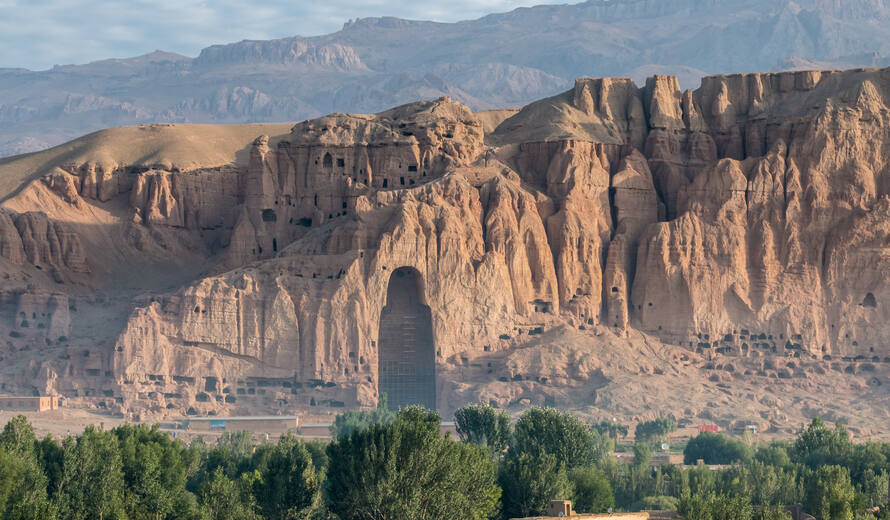Commemorating 20 years since the destruction of two Buddhas of Bamiyan, Afghanistan
The tragic destruction of the Buddhas of Bamiyan in March 2001, which was broadcast across the globe, led to a global recognition of the need to protect cultural heritage at risk.
The empty niches of the giant Buddhas in the Bamiyan Valley of Afghanistan are a perpetual reminder of our duty to protect cultural heritage, and what future generations stand to lose if we do not. Today, these niches are inscribed on the World Heritage List as part of the “Cultural Landscape and Archaeological Remains of the Bamiyan Valley” World Heritage property.
Although the destruction of heritage and the plundering of artefacts has taken place since antiquity, the destruction of the two Buddhas of Bamiyan represented an important turning point for the international community. A deliberate act of destruction, motivated by an extremist ideology that aimed to destroy culture, identity and history, the loss of the Buddhas revealed how the destruction of heritage could be used as a weapon against local populations. It highlighted the close links between heritage safeguarding and the well-being of people and communities. It reminded us that defending cultural diversity is not a luxury, but rather fundamental to building more peaceful societies.
Since the destruction of the Buddhas of Bamiyan, the Afghan authorities and the international community, including UNESCO, have worked tirelessly to safeguard the rich cultural and natural heritage of Afghanistan, which testifies to millennia of exchanges between different cultures and peoples. In 2003, the Cultural Landscape and Archaeological Remains of the Bamiyan Valley was inscribed simultaneously on the World Heritage List and the List of World Heritage in Danger, in light of the extreme fragility of the niches, the lack of a management framework, and concerns over safety and security.
Since then, thanks to solid and lasting international cooperation, more than USD$27 million have been invested in the conservation and stabilization of the Bamiyan World Heritage property, the empowerment of local communities, the revitalization of intangible cultural heritage, and the construction of a Cultural Centre for Bamiyan dedicated to creativity, among other activities. International partners have remained engaged in this endeavor through operational projects, in particular six successive phases of a project to stabilize the niches that were in danger of collapsing. After more than 15 years, the consolidation of the eastern Buddha niche has been completed, while urgent work is progressing to safeguard the western niche, thanks to funding from Japan. This cooperation has also been extended to seven other component sites in the Bamiyan Valley, including caves covered with murals, remarkable expressions of Indian and Chinese influences along the Silk Roads, and Shahr-e Gholghola Fortress, which marks the origin of the settlement of Bamiyan. These endeavors are supported financially and technically by Japan and Italy. UNESCO has also been pleased to partner with the European Union, Germany, the Republic of Korea, Switzerland and others on its work on Bamiyan.
An international conference in 2017 highlighted the need for further studies on any possible reconstruction of the Buddhas. UNESCO and Springer recently published “The Future of the Bamiyan Buddha Statues: Heritage Reconstruction in Theory and Practice”, a collection of scientific papers on this extremely complex issue. When we consider heritage reconstruction, each case is unique, and this situation calls for an approach with a deep respect for local communities. UNESCO and its partners have continued to work on this topic, notably through the "International Conference on Reconstruction: The Challenges of World Heritage Recovery", held in Warsaw in May 2018, which resulted in the Warsaw Recommendation on Recovery and Reconstruction of Cultural Heritage.
Tragically, since Bamiyan, we have seen the further intentional destruction of cultural heritage in Syria, Iraq, Libya, Mali and elsewhere. Yet the international community has not stayed silent in the face of these acts of violence. In the wake of Bamiyan, UNESCO’s Member States adopted the Declaration on the Intentional Destruction of Cultural Heritage on 17 October 2003. Following the destruction of cultural heritage sites in Timbuktu in 2012, the intentional destruction of cultural heritage was recognized by the international community as a war crime. In 2016, the International Criminal Court found a defendant guilty of war crimes for the directing the 2012 destruction of mausoleums in Timbuktu, the first such ruling by the court. In recent years, UNESCO, including through its Heritage Emergency Fund, has supported reconstruction and emergency preparedness and response efforts in over 60 countries.
As we mark 20 years since the destruction in Bamiyan, we at UNESCO reiterate our support to the Afghan people and reinforce our commitment to stand together with people everywhere to safeguard cultural heritage as an embodiment of our common humanity.
Ernesto Ottone R.
UNESCO Assistant Director-General for Culture
More information on Bamiyan
-
2001
Destruction
-
2002
-
2003
-
2004
Expert Working Group releases recommendations for Safeguarding Bamiyan (in 4 phases)
-
2004
-
2005
-
2005
Fourth Expert Working Group on the preservation of the Bamiyan World Heritage site
-
2007
-
2008
Sixth Expert Working Group for the Preservation of the Bamiyan Site
-
2008-2011
-
2011
Expert Working Group releases recommendations for Bamiyan Valley, Afghanistan
-
2011
-
2011
-
2012
Expert Working Group releases recommendations for Bamiyan Valley, Afghanistan
-
2012-2014
-
2013
11th Expert Working Group releases recommendations for Safeguarding the Bamiyan Valley, Afghanistan
-
2013
-
2013
2013: A cultural centre and museum to be built at the Bamiyan World Heritage Site
-
2014
UNESCO Announces the Bamiyan Cultural Centre Design Competition
-
2016
The 13th Bamiyan Expert Working Group Meeting met in Germany
-
2017
-
2017
-
2017
-
2018
-
2020
